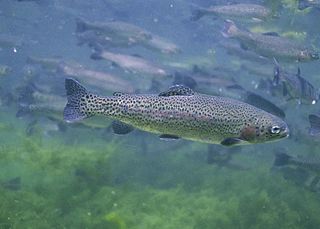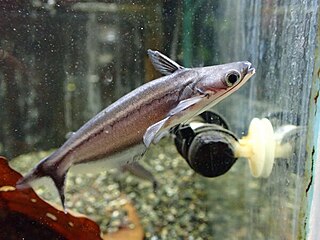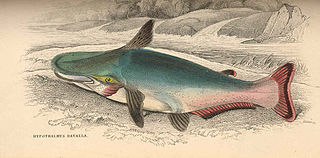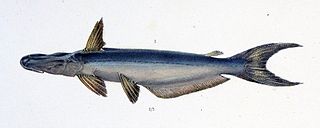
The Scorpaeniformes are a diverse order of ray-finned fish, including the lionfishes and sculpins, but have also been called the Scleroparei. It is one of the five largest orders of bony fishes by number of species, with over 1,320.

The rainbow trout is a species of trout native to cold-water tributaries of the Pacific Ocean in Asia and North America. The steelhead is an anadromous (sea-run) form of the coastal rainbow trout(O. m. irideus) or Columbia River redband trout (O. m. gairdneri) that usually returns to freshwater to spawn after living two to three years in the ocean. Freshwater forms that have been introduced into the Great Lakes and migrate into tributaries to spawn are also called steelhead.
Steelhead, or occasionally steelhead trout, is the anadromous form of the coastal rainbow trout (Oncorhynchus mykiss irideus) or Columbia River redband trout. Steelhead are native to cold-water tributaries of the Pacific basin in Northeast Asia and North America. Like other sea-run (anadromous) trout and salmon, steelhead spawn in freshwater, smolts migrate to the ocean to forage for several years and adults return to their natal streams to spawn. Steelhead are iteroparous, although survival is approximately 10–20%.

The driftwood catfishes are catfishes of the family Auchenipteridae. The two genera of the former family Ageneiosidae have been placed here, resulting in a grouping of about 125 species in about 22 genera.

The Chinook salmon is the largest and most valuable species of Pacific salmon. Its common name is derived from the Chinookan peoples. Other vernacular names for the species include king salmon, Quinnat salmon, Tsumen, spring salmon, chrome hog, Blackmouth, and Tyee salmon. The scientific species name is based on the Russian common name chavycha (чавыча).

Carl Henry Eigenmann was a German-American ichthyologist of the late nineteenth and early twentieth centuries, who, along with his wife Rosa Smith Eigenmann, and his zoology students is credited with identifying and describing for the first time 195 genera containing nearly 600 species of fishes of North America and South America. Especially notable among his published papers are his studies of the freshwater fishes of South America, the evolution and systematics of South American fishes, and for his analysis of degenerative evolution based on his studies of blind cave fishes found in parts of North America and in Cuba. His most notable works are The American Characidae (1917–1929) and A revision of the South American Nematognathi or cat-fishes (1890), in addition to numerous published papers such as "Cave Vertebrates of North America, a study of degenerative evolution" (1909) and "The fresh-water fishes of Patagonia and an examination of the Archiplata-Archelenis theory" (1909).

The California Department of Fish and Wildlife (CDFW), formerly known as the California Department of Fish and Game (CDFG), is a state agency under the California Natural Resources Agency. The Department of Fish and Wildlife manages and protects the state's wildlife, wildflowers, trees, mushrooms, algae and native habitats (ecosystems). The department is responsible for regulatory enforcement and management of related recreational, commercial, scientific, and educational uses. The department also prevents illegal poaching.

Entomocorus is a genus of catfishes of the family Auchenipteridae.

Ageneiosus is a genus of driftwood catfishes found mostly in South America with one species extending into Central America.
Moro Cojo Estuary State Marine Reserve (SMR) is a marine protected area established to protect the wildlife and habitats in Moro Cojo Slough. Moro Cojo Slough is located inland from Monterey Bay on the central coast of California, directly south of the more widely known Elkhorn Slough. The area covers 0.46 square miles (1.2 km2). The SMR protects all marine life within its boundaries. Fishing and take of all living marine resources is prohibited.

Natural Bridges State Marine Reserve (SMR) is a marine protected area located at the northern edge of Santa Cruz, California, approximately 75 miles (121 km) south of San Francisco. The SMR covers 0.58 square miles (1.5 km2). The SMR protects all marine life within its boundaries. Fishing or other removal of any living marine resource is prohibited.

The North Table Mountain Ecological Reserve is a nature reserve of 3,315 acres (13.42 km2) located three miles (5 km) north of Oroville, in Butte County, northern California. The land was acquired by the state in October, 1993.

Ageneiosus inermis is a species of driftwood catfish of the family Auchenipteridae. It can be found throughout South America, from Colombia and Venezuela to Uruguay and northern Argentina.
Ageneiosus magoi is a species of driftwood catfish of the family Auchenipteridae. It can be found on the Orinoco Basin.

Ageneiosus militaris is a species of driftwood catfish of the family Auchenipteridae. It can be found in the La Plata River basin in South America.
Ageneiosus pardalis is a species of driftwood catfish of the family Auchenipteridae. It can be found in the Maracaibo Lake.
Ageneiosus polystictus is a species of driftwood catfish of the family Auchenipteridae. It can be found on the Amazon basin.

Ageneiosus ucayalensis is a species of driftwood catfish of the family Auchenipteridae. It can be found in South America.

Ageneiosus vittatus is a species of driftwood catfish of the family Auchenipteridae. It can be found in the Amazon basin and the Orinoco River.
The Puduari River is a river in the state of Amazonas, Brazil. It is a tributary of the Rio Negro.













